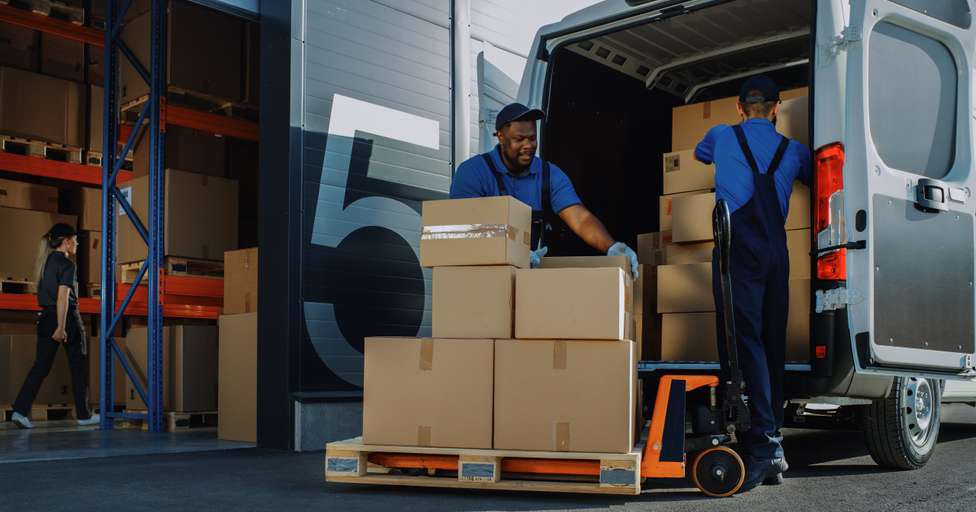Shipping in eCommerce is more important than ever. Your shoppers want to enjoy fast, cost-effective delivery with their favorite carriers. However, an inefficient shipping strategy can not only become a major obstacle, affecting delivery processes, customer satisfaction, and profit margins, but it will also increase your logistics costs.
This eCommerce shipping guide aims to address the most relevant questions: What does shipping involve, what does it cost, how does it work, what is the role of carriers and logistics, and how can shipping costs be optimized? What software or solutions are needed to manage shipping? Lets see how to handle shipping for online store like a professional
What is eCommerce shipping?
Shipping in eCommerce involves the practices and processes that an online shop uses to transport merchandise sold to the end customer. But shipping is more than just a logistical issue; it also defines the customer's ordering experience. An inadequate shipping policy can lead to dissatisfied customers, returns, and lost profits.
The shipping policy
The shipping policy of an eCommerce store is a digital document that defines all the conditions and terms under which deliveries are made. This document should be clear and detailed, including information on delivery times, shipping costs, available carriers, tracking options, and other relevant aspects.
A well-defined policy improves transparency, reduces uncertainty, and eliminates misunderstandings that can arise during the purchasing process.
How eCommerce shipping works: management models
The way shipping works in eCommerce depends directly on the logistics management model you adopt.
Dropshipping
In the dropshipping model, products are shipped directly from the supplier to the end customer. The merchant does not handle any logistics. This model is ideal for small businesses or entrepreneurs, as it eliminates the need for warehousing and shipping.
Manual shipping
The merchant performs all logistical tasks without any digital automation. This method is suitable for small businesses with low order volumes that can afford to contact carriers directly.
Manual logistics is often very inefficient. If you opt for this model, you will have to apply techniques to improve the shipping process.
Third-party logistics provider (3PL)
With a 3PL solution, logistics operations are outsourced to a third-party provider that handles everything from inventory management to delivery. This is the most expensive option of all.
Integration via a multi-carrier API
This is the most common model. The eCommerce platform uses multi-carrier shipping softwareto connect with its logistics providers. This allows for automatic and error-free generation of shipping labels, tracking, and collection coordination with any carrier.
The shipping process explained in detail

Confirmation of purchase
The shipment starts with the confirmation of the purchase. When a customer purchases a product, the system receives the order information. It then verifies that the ordered products are available in stock and validates the payment information.
Once confirmed, a unique order number is assigned, facilitating order tracking and management for both the customer and eCommerce. An internal notification is then generated to inform warehouse staff so they can prepare the order.
Shipping process in the warehouse
The next stage involves the preparation and logistics of the shipment. In the warehouse, operators use picking lists to locate and pick each product in the order.
This stage is crucial, as correct picking ensures that there are no errors in the order. Once picked, the products undergo a quality inspection to ensure that there are no faulty or incorrect items. They are then securely packed using appropriate packaging materials to protect the items during transport.
Shipping documentation process
First of all, the scheduling of the collection of the parcel with the respective transport company is initiated. This is done manually or with a parcel shipping software (depending on the management model).
Then, a shipping label containing all relevant details such as the delivery address and the barcodes required for tracking is printed and affixed to a visible place on the parcel. To print the shipping labels correctly, it is important to select a format compatible with the shipping label printer used (e.g., PDF, ZPL, EPL).
Tracking and shipping delivery
It is important to send shipping notifications throughout the shipping and delivery process. These notifications include essential information: the order number, a summary of the products and quantities, the total price, billing and shipping details, the estimated delivery date, or a link to the shop's tracking page.
Pro Tip: Shipment tracking as a marketing experience
With tracking software, you can customize notifications with designs or promotions relevant to the items purchased. This way, every time a shopper checks the status of their order, there's a chance they'll make an additional purchase.
Returns and customer service
Returns management and customer service are crucial to the long-term success of an eCommerce business. Implementing a returns portal makes it easier for customers to manage their returns and enables the automatic generation of return authorization numbers (RMAs) as well as return labels. For customer service, it is advisable to add options such as live chat or ticketing systems, which allow agents to resolve customer queries quickly and efficiently.
What are the shipping methods in retail?
The shipping methods available depend to a large extent on the integrated carriers. For example, if a shop is connected with express delivery services, it may be able to offer fast delivery options to its customers. On the other hand, if the integration is with slower carriers, the shipping methods offered may be geared towards cheaper options.
Domestic shipments
Domestic shipments are sent within a country. Carriers handle these shipments through their own distribution centers. They typically take 3-5 business days. It is a common and economical option for customers who do not need to receive their products urgently.
Overnight shipping
Overnight shipping is ideal for customers who need to receive their goods urgently. The courier transports the goods overnight for next-day delivery. However, this method is usually only available in metropolitan areas and costs extra.
Two-day delivery
Two-day delivery is a popular option for customers who want to receive their goods quickly but do not need immediate delivery. This service offers a balance between speed and cost, with a two-day delivery time. The cost of this type of delivery ranges from $10 to $30, depending on the supplier and distance.
International shipping
International shipping in eCommerce allows you to transport products to customers in other countries. This type of shipping is more complex due to the regulations and documentation required. Standard international shipments can take 7 to 20 business days, while express shipments can take 2 to 5 days.
Green Shipping
Green shipping focuses on minimizing the environmental impact of product delivery. This may include using recycled packaging, optimizing delivery routes to reduce carbon emissions, and choosing carriers that use electric or low-emission vehicles.
Pick and point
With pick and point delivery, customers can choose to pick up their products at a designated collection point instead of waiting for home delivery. It offers flexibility and convenience, especially for customers who may not be available for home delivery during certain hours.
Cash on delivery
Cash on delivery allows customers to pay for their purchases directly to the carrier upon receiving the package. It's a convenient payment method for customers who prefer not to pay online or who may not have access to online payment options.
DAP shipping
DAP, or Delivered at Place, is an Incoterm used in international trade to define the responsibilities between the seller and the buyer regarding the delivery of goods. Under DAP shipping, the seller is responsible for delivering the goods to the named place of destination, typically the buyer's location or another agreed-upon location.
Carbon neutral shipping
Blind shipping is a method used in logistics and shipping where the sender (usually a manufacturer or retailer) ships goods directly to the end customer without revealing the identity of the sender to the recipient.
Expedited shipping
Expedited shipping refers to a shipping method that prioritizes fast delivery of packages to customers. It's designed to significantly reduce the transit time compared to standard shipping options.
Economic shipping
Economy shipping is the most affordable option, prioritizing price over speed. This method is suitable for customers who are willing to wait longer for their deliveries in exchange for a lower shipping cost. Typically, economy shipping costs between $3 and $5 and can take 5 to 7 business days.
Shipping zones and carriers

Shipping zones are the geographical areas that a transport company covers with its services. These areas are defined by considering various factors, such as the distance to be covered, ease of access, population density and the transport infrastructure available in each region.
Carriers divide them into different categories according to the speed of delivery or the associated costs. Generally, these categories include domestic, international, local and regional shipments. For example, a domestic shipment may refer to delivery within the same country, while an international shipment involves sending products to other countries. Here you can see the shipping zones of UPS internationally and in the USA.
When choosing a carrier for your shipments, it is important to consider your specific needs. This includes considering whether your shipments are local or international, the carrier's reputation, the technologies they offer (such as real-time tracking systems), the speed of delivery (including express options such as 2-day shipping), the associated costs, the delivery guarantee, and the weight and dimensional restrictions of your packages.
To help you make informed decisions, we have created a table with shipping cost estimates and a list of the best carriers available for your specific needs. This table will help you compare and select the best shipping method for your eCommerce business.
| Shipping Method | Provider | Features | Estimated Price |
|---|---|---|---|
| Same-Day Delivery | DoorDash, Instacart, Shipt | Ideal for fast deliveries in cities. Higher costs. | $5-$15 |
| Two-Day Delivery | FedEx Ground, UPS Ground, USPS Priority Mail | Good national coverage. Reliable delivery times. | $10-$30 |
| International Shipping | DHL, FedEx, UPS | Wide global distribution network. Higher costs for long-distance shipments | Standard: $20-$60 Express: $50-$120 |
| Eco-Friendly Shipping | UPS Carbon Neutral, FedEx EarthSense | Utilizes sustainable transportation methods and offsets CO2 emissions. | Varies depending on conditions |
| Next-Day Delivery | FedEx Overnight, UPS Express | Ideal for urgent overnight deliveries. High costs. | $30-$60 |
| Pickup Point Delivery | FedEx Hold at Location, UPS Access Point | Wide network of pickup points across the United States. Economical costs. | $5-$15 |
| Cash on Delivery | FedEx COD, UPS COD | Payment is made at the time of delivery. Increased security for the seller. | Percentage of package value |
| Expedited Shipping | FedEx Overnight Priority, UPS Next Day Air | Extremely fast delivery times. Very high costs. | $25-$70 |
| Domestic Shipping | USPS First Class Mail, UPS Mail Innovations | Most economical option for lightweight and low-value shipments. Slower delivery times. | $5-$20 |
Pro Tip: Analyze Your Carriers' Performance
Utilize an analytics tool such as Outvio's to identify the most efficient carriers for each geographic area. By pinpointing potential patterns, you can consistently select the most cost-effective and efficient shipping option, ultimately reducing the expenses associated with your eCommerce shipments.
How much does eCommerce shipping cost?
Learning how to calculate shipping costs is important. By understanding the different factors that affect shipping, such as rates and packaging, you will be able to take focused action to reduce the cost of shipping, without compromising the delivery experience.
The three most important factors for shipping costs are packaging, volumetric weight and carrier rate.
Shipping rates
The shipping rate for e-commerce shipments is the price charged by a carrier to transport a package from the point of origin (the seller's warehouse) to the point of destination (the customer's address). This rate is calculated based on several factors and can vary significantly from shipment to shipment. Typically, e-commerce companies with a higher volume of shipments negotiate fixed shipping rates at a lower price.
Pro Tip: How to negotiate shipping rates
Negotiating favorable shipping rates is essential to eCommerce profitability. Analyze your shipping volumes and compare services and rates from different carriers. Develop a detailed request for proposal (RFP) and send it to several carriers, highlighting your growth potential to secure better offers. During the negotiation, consider not only price, but also transit times, delivery guarantees, and additional services. Sometimes, better service justifies a slightly higher cost.
Volumetric weight
Volumetric weight is a measurement used by carriers to calculate the cost of shipping based on the space a package occupies rather than its actual weight. It is calculated by multiplying the length, width and height of the package and dividing the result by a specific dimensionality factor set by the carrier.
Ecommerce shipping packaging
Packaging is another cost that mostly affects the price of your eCommerce shipments. The more protection you add to orders, the more expensive the total cost will be, but you will also minimize damage and incidents. There are ways to minimize packaging costs, from ensuring that packaging fits the size of the product so you don't pay for excess space, to negotiating the purchase of large quantities from your suppliers.
| Type | Material | Dimensions | Price per unit |
|---|---|---|---|
| Standard self-assembling box | Single-face cardboard | 20 x 20 x 20 cm | Between €0.20 and €0.50 |
| Self-assembling box with lid and bottom | Double-face cardboard | 30 x 30 x 30 cm | Between €0.50 and €1.00 |
| Bubble mailer with self-adhesive closure | Plastic with air bubbles | 25 x 15 cm | Between €0.10 and €0.20 |
| Bubble mailer with gusset | Plastic with air bubbles | 40 x 30 x 10 cm | Between €0.30 and €0.50 |
| Tissue paper | Paper | 1 kg | Between €2.00 and €3.00 |
| Styrofoam peanuts | Expanded polystyrene | 1 m³ | Between €5.00 and €10.00 |
| PVC adhesive tape | PVC | 50 mm x 50 m | Between €2.00 and €3.00 |
| White adhesive label | Paper | 10 x 50 mm (100 units) | Between €2.00 and €3.00 |
Exceptions, insurance and claims

Challenges such as delays, shipping damage, or loss of packages can arise, affecting the customer experience and the company's reputation. In fact, between 7% and 11% of customers' online orders arrive broken or damaged. What should be done in case of damaged shipments? Who covers the costs? Is it possible to file claims?
What are shipping exceptions?
Shipping exceptions are any unexpected event or problem that occurs during the process of shipping a product or package to the end customer. These incidents can arise for a variety of reasons, from human error to fortuitous events, and can have a significant impact on the customer experience, company reputation and financial results.
The most common types of shipping incidents are:
- Delivery delays
- Product damage
- Parcel losses
- Address errors
- Miscommunication
What is shipping and transport insurance?
Shipping insurance is a policy that protects retailers against financial losses they may suffer as a result of damage, loss, or theft of goods during transportation. These insurances provide cover for a wide range of risks, including:
- Physical damage to goods during transport
- Total or partial disappearance of the goods
- Illegal theft of the goods
Any eCommerce that ships goods by any means of transport, such as road, sea, air, or rail, can benefit from shipping insurance. Also shipping insurance is common in certain businesses. For example, those that package and ship electronics.
How much does shipping insurance cost?
The price of shipping insurance in eCommerce is mainly determined by the value of the item shipped, the type of product, the shipping destination, and the shipping method selected. In addition, claims history, deductibles, and desired coverage influence the rate. Price variation also depends on the insurance provider.
What are transport claims?
Transport claims protect the interests of your eCommerce in case of damage, loss, or delay in the delivery of goods during transport. They are formal requests for compensation for damages suffered.
Claims are based on the contract of carriage established between the shipper and the carrier, which defines the responsibilities of each party and the conditions of service. In case of non-compliance with these conditions, the shipper has the right to claim compensation for damages suffered.
Most carriers have specific channels for the submission of claims. You can also file transportation claims through a global shipping software such as Outvio.
Most used shipping strategies in eCommerce
Offering free shipping to increase sales
This approach, supported by 80% of online shoppers, is based on consumer psychology. Customers are willing to wait longer for delivery if they don't have to pay for shipping. By removing this obstacle with free shipping, you not only encourage purchase completion but also add tangible value to the customer experience, strengthening their trust and satisfaction.
Increase order value with a minimum order threshold
Establishing a minimum purchase amount to qualify for free shipping is a strategy that encourages customers to raise the value of their shopping carts to meet that threshold. This tactic not only incentivizes additional purchases but can also boost overall sales by prompting customers to explore more products to meet the threshold requirement.
Split orders to reduce customer delivery times
You can split the shipment of products when you are out of stock so that your customer can enjoy part of their purchase as soon as possible. This shipping strategy is used to prevent buyer frustration in case an item in the order is unavailable.
BOPIS (Buy Online, Pick Up In Store)
BOPIS combines the convenience of e-commerce with the physical store shopping experience. By allowing customers to buy online and pick up their products in a physical store, it reduces shipping costs and delivery times while encouraging personal interaction with the brand and strengthening the bond with the customer.
Multi-carrier shipping strategy
Involves partnering with multiple carriers to offer diversified shipping options and negotiating competitive rates with each. Selecting the right carrier for each shipment is key to ensuring efficient and cost-effective delivery. In addition, thanks to shipping solution with allocation rules, your eCommerce will be able to automatically choose the most cost-effective carrier, increasing the profitability of your workflow.
Personalization and cross-selling
Personalization and cross-selling involve customizing messages and the tracking portal with branding and promotional elements of relevant items. Follow-up notifications have a 90% open rate, so promoting items in them is an effective way to acquire additional revenue.
Automations
Ecommerce shopping automation involves optimizing the shipping process by automating repetitive tasks such as label generation and shipment tracking. This improves the efficiency of the shipping process, reduces errors, and enables centralized management from receipt to delivery. To achieve this, it is necessary to invest in cloud-shipping management software
How Outvio helps you with your eCommerce shipments
Outvio is the leading platform for automating post-checkout processes in eCommerce. Connect with carriers around the world and optimize your shipping and returns operations from start to finish. Centralize your processes in a tool designed to transform your customers' shopping experience into a competitive advantage.
How does Outvio help with your shipping process?
- Carrier integrations: Automatically and securely ship anywhere in the world.
- Fulfillment and logistics: Create digital picking lists, verify order merchandise automatically, and print shipping documents in bulk.
- Automation rules: Intelligently assign the most suitable carrier for each order according to your criteria.
- Incident control: Monitor every problem you encounter with your shipments and take instant resolution actions.
- Tracking portal: Integrate into your online store a portal with an interactive map in real-time to keep your customers always informed.
- Returns and exchanges portal: Transform your returns into an additional sales channel with in-store credit and automatic exchanges.
- Notifications: Choose under which conditions you want emails, WhatsApp, and SMS to be sent to your customers and carriers.
- Integrated customer support software: Integrate a chat and ticketing system into your eCommerce and guarantee the best support service.
And much more.
